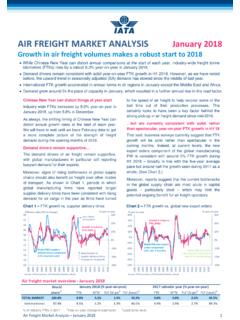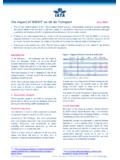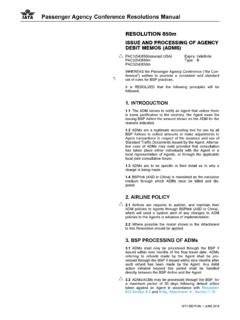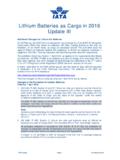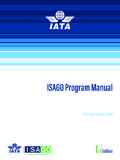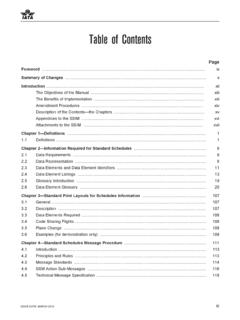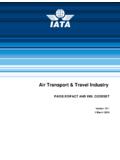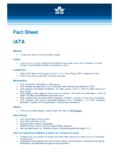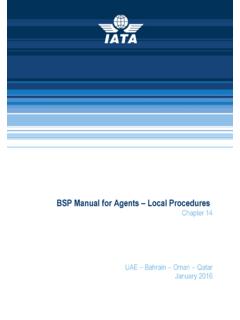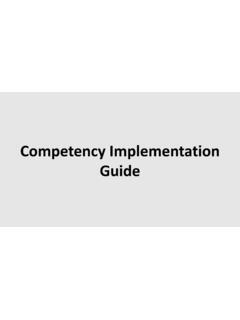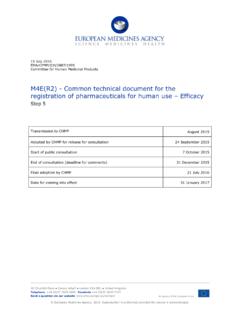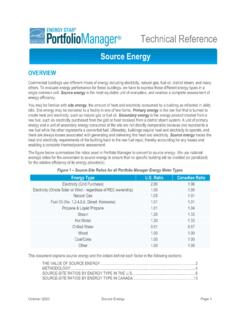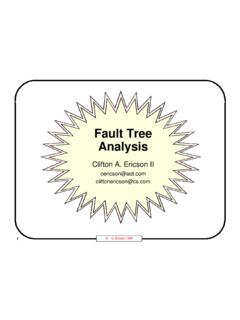Transcription of Fact Sheet 2 - IATA
1 1 fact Sheet 2 fact Sheet 2 Sustainable Aviation Fuel: Technical Certification Sustainable Aviation Fuel (SAF) must have the same qualities and characteristics as conventional jet fuel in order to substitute it. This is important to ensure that manufacturers do not have to redesign engines or aircraft, and that fuel suppliers and airports do not have to build new fuel delivery systems, which could be necessary for alternatives such as hydrogen or electrification. At present, the industry is focused on producing SAF as a drop-in replacement to conventional jet fuel.
2 Drop-in fuels are entirely fungible with conventional kerosene requiring no adaptation of engines of associated delivery infrastructure. Taking into consideration that the same aircraft can be fueled in different countries, international specifications have been adopted for jet fuels. The two most widely utilized standards to ensure jet fuel is fit for purpose is American Society for Testing Materials (ASTM) standard number D1655 and DEF STAN 91- 91. The ASTM sets requirements for criteria such as composition, volatility, fluidity, combustion, corrosion, thermal stability, contaminants, and additives, among others to ensure that the fuel is compatible when blended.
3 The drop-in condition is a major requirement for the aviation industry. Any SAF that doesn t meet this condition could present safety issues associated with risks of mishandling, and would require a parallel infrastructure to be implemented in all connected airports, creating unnecessary risks and costs. The standard regulating the technical certification of SAF is ASTM D7566. This evaluates which technologies, under specific circumstances and characteristics, can be used for producing on specification neat SAF.
4 Practically, a SAF is produced in a bio-refinery and then can be blended up to the maximum certified blending limit. Upon release from blending the fuel is certified to ASTM D1655 and from this point is regarded as conventional Jet A or Jet A1 kerosene. Figure 2 shows the seven technology pathways that can currently produce drop-in SAFs. These technologies are Fischer-Tropsch (FT), Fischer-Tropsch containing aromatics (FT-SKA), Hydroprocessed Esters and Fatty Acids (HEFA), Direct Sugars to Hydrocarbons producing Synthetic Iso-Paraffins (SIP), and Alcohol-to-Jet (ATJ) which includes isobutanol and ethanol.
5 Many additional technologies are under evaluation by ASTM. In 2020, Catalytic Hydrothermolysis Jet fuel (CHJ) and Hydroprocessed Hydrocarbons (HH-SPK or HC-HEFA) became approved technologies. Technology Maximum blend (%v/v) Feedstocks FT & FT-SKA 50 Wastes (MSW, etc.), coal, gas, sawdust HEFA 50 Vegetable oils: palm, camelina, jatropha, used cooking oil. HH-SPK or HC-HEFA 10 Oils produced from (botryococcus braunii) algae Synthesized Iso-Paraffin 10 Sugarcane, sugar beet ATJ (Isobutanol and Ethanol) 50 Sugarcane, sugar beet, sawdust, lignocellulosic 2 Sustainable Aviation Fuel: Technical Certification residues (straw) Catalytic Hydrothermolysis Jet fuel (CHJ) 50 Waste oils or energy oils Figure 2: current technologies, maximum blend allowed and most common feedstocks for drop-in SAFs as defined under standard ASTM D7566.
6 Source: Adapted from ICAO CAAF/2-WP/7. SAF technical certifications pathways At present, the key criteria for industry is the ability of the SAF to be dropped-in to conventional jet fuel, with a maximum limit of 50% of the blend. 1. Fischer Tropsch synthesized isoparaffinic kerosene (FT-SPK) FT-SPK was approved by ASTM for incorporation into ASTM D7566 in September, 2009. In the FT-SPK process, coal, natural gas, or biomass feed stocks are gasified into a syngas comprised of hydrogen and carbon monoxide.
7 This syngas is then catalytically converted to a liquid hydrocarbon fuel blending component in the FT reactor. Fischer Tropsch synthesized kerosene with aromatics (FT-SPK/A) was approved by ASTM for incorporation into ASTM D7566 in November 2015. FT-SPK/A is a variation of the FT process where a fully-synthetic alternative aviation fuel containing aromatics is produced. 2. Synthesized iso-paraffins (SIP) SIP was approved by ASTM for incorporation into ASTM D7566 in July, 2014. The SIP process utilizes a fermentation process to convert a sugar feed stock into a hydrocarbon molecule that can be blended into conventional jet fuel.
8 3. HH-SPK (Hydroprocessed Hydrocarbons- synthesized isoparaffinic kerosene) or HC-HEFA HH-SPK was added in May 2020 for ASTM D7566 as an alternative jet fuel production pathway. This addition describes the hydroprocessing of bio-derived hydrocarbons (unlike the fatty acids or fatty acid esters found in HEFA production) which comes from oils found in a specific algae (botryococcus braunii). 4. Hydroprocessed fatty acid esters and fatty acids (HEFA) HEFA was approved by ASTM for incorporation into ASTM D7566 in June, 2011.
9 In the HEFA process, lipid feedstocks such as plant or algae oils, tallow (animal fats), or waste greases such as cooking oils are deoxygenated and then hydroprocessed to produce a pure hydrocarbon fuel blending component. 5. Alcohol to jet (ATJ) ATJ was approved by ASTM for incorporation into ASTM D7566 in April 2016 using isobutanol at blend limit 50%. The ATJ process utilizes dehydration, oligomerization, and hydro processing to convert alcohol feed stocks to a pure hydrocarbon fuel blending component.
10 In April 2018 Ethanol was included as an ATJ feedstock with a blend limit of 50%. 6. Catalytic Hydrothermolysis Jet fuel (CHJ) In the CHJ process (also called hydrothermal liquefaction), clean free fatty acid (FFA) oil from the processing of waste oils or energy oils is combined 3 Sustainable Aviation Fuel: Technical Certification with preheated feed water and then passed to the CH reactor. There, under very high temperature and pressure conditions, a single phase is formed consisting of FFA and supercritical water (SCW) wherein the FFAs are cracked, isomerized, and cyclized into paraffin, isoparaffin, cycloparaffin, and aromatic compounds.
